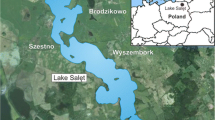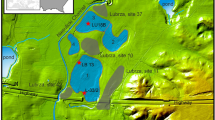Abstract
A palynological and sedimentological investigation of two lake sediment cores retrieved from Bafa Gölü (western Turkey) was carried out as a contribution to the environmental history of the lower Büyük Menderes river valley during the later Holocene. Woods of mainly deciduous oak represent the climax vegetation around Bafa Gölü. Human impact on the ecosystem, starting at the latest during the so-called “Beyşehir occupation phase” in the late second millennium b.c., resulted in the transition to open woodland and maquis scrub. Local settlement phases such as woodland clearance and associated erosion/accumulation features can be detected by pollen as well as sedimentological analyses. The strongest human impact can be detected at the time of the Greek period in the seventh to first century b.c. and especially during the Roman period in the first century b.c. until the fourth century a.d., when sedimentation was 5–6 times greater than in the periods before and after.





Similar content being viewed by others
References
AG Boden (1994) Bodenkundliche Kartieranleitung, 4th edn. On commission by E. Schweizerbart´sche Verlagsbuchhandlung (Nägele u. Obermiller, Stuttgart), Hannover
Bay B (1999) Geoarchäologie, anthropogene Bodenerosion und Deltavorbau im Büyük Menderes Delta (SW-Türkei). GCA, Bochum
Behre K-E (1990) Some reflections on anthropogenic indicators and the record of prehistoric occupation phases in the pollen diagrams from the Near East. In: Bottema S, Entjes-Nieborg G, van Zeist W (eds) Man′s role in the shaping of the Eastern Mediterranean landscape. Balkema, Rotterdam, pp 219–230
Beug H-J (1961a) Leitfaden der Pollenbestimmung für Mitteleuropa und die angrenzenden Gebiete. Lfg 1. Fischer, Stuttgart
Beug H-J (1961b) Beiträge zur postglazialen Floren- und Vegetationsgeschichte Süddalmatiens: Der See, Malo Jezero” auf Mljet. Flora 150:600–656
Beug H-J (1975) Man as a factor in the vegetational history of the Balkan peninsula. Problems of Balkan flora and vegetation. Sofia, Bulgaria, pp 72–78
Beug H-J (1977) Vegetationsgeschichtliche Untersuchungen im Küstenbereich von Istrien (Jugoslawien). Flora 166:357–381
Beug H-J (2004) Leitfaden der Pollenbestimmung. Pfeil, München
Bottema S, Woldring H (1984(1986)). Late Quaternary vegetation and climate of southwestern Turkey. Part II. Palaeohistoria 26:123–149
Bottema S, Woldring H (1990) Anthropogenic indicators in the pollen record of the Eastern Mediterranean. In: Bottema S, Entjes-Nieborg G, van Zeist W (eds) Man´s role in the shaping of the Eastern Mediterranean landscape. Balkema, Rotterdam, pp 231–264
Bozkurt E, Oberhänsli R (2001) Menderes Massif (western Turkey): structural, metamorphic and magmatic evolution. A synthesis. Int J Earth Sci 89:679–708
Brinkmann R, Köhler B, Heins J-U, Rösler S (1991) Menderes-Delta. Zustand und Gefährdung eines ostmediterranen Flussdeltas. (Arbeitsbericht des Fachbereichs Stadt- und Landschaftsplanung der Gesamthochschule Kassel 99), Kassel
Brückner H (1996) Geoarchäologie an der türkischen Ägäisküste. Landschaftswandel im Spiegel geologischer und archäologischer Zeugnisse. Geogr Rundschau 10/1996:568–574
Brückner H (1998) Coastal research and geoarchaeology in the Mediterranean region. In: Kelletat DH (ed) German geographical coastal research—The last decade. Institute for Scientific Co-operation, Tübingen and Committee of the Federal Republic of Germany for the International Geographical Union, Tübingen, pp 235–258
Brückner H (2003) Delta evolution and culture—aspects of geoarchaeological research in Miletus and Priene. In: Wagner GA, Pernicka E, Uerpmann HP (eds) Troia and the Troad. Scientific approaches, Springer, Berlin, pp 121–144
Brückner H, Müllenhoff M, Handl M, van der Borg K (2002) Holocene landscape evolution of the Büyük Menderes alluvial plain in the environs of Myous and Priene (Western Anatolia, Turkey). Z Geomorph NF suppl vol 127:47–65
Brückner H, Müllenhoff M, van der Borg K, Vött A (2004) Holocene coastal evolution of western Anatolia—the interplay between natural factors and human impact. In: CIESM (Commission Internationale pour l’Exploration Scientifique de la mer Méditerranée): Human records of recent geological evolution in the Mediterranean Basin—historical and archaeological evidence (Santorini, Greece, 22–25 October 2003). Workshop Monographs 24, Monaco, pp 51–56
Brückner H, Müllenhoff M, Gehrels R, Herda A, Knipping M, Vött A (2006) From archipelago to floodplain—geographical and ecological changes in Miletus and its environs during the last six millennia (Western Anatolia, Turkey). Z Geomorph NF suppl vol 142:63–83
Davis PH (ed) (1965–1988) Flora of Turkey and the East Aegean Islands, 1–10. Edinburgh University Press, Edinburgh
Eastwood WJ, Roberts N, Lamb HF (1997) A pollen-based record of Holocene environmental change in southwest Turkey. In: The late Quaternary in the Eastern Mediterranean. An international symposium at MTA general directorate. Program and abstracts. Ankara
Eastwood WJ, Roberts N, Lamb HF, Tibby JC (1999) Holocene environmental change in southwest Turkey: a palaeoecological record of lake and catchment-related changes. Quat Sci Rev 18:671–695
Eisele G, Haas K, Liner S (1994) Methode zur Aufbereitung fossilen Pollens aus minerogenen Sedimenten. In: Frenzel B (ed) Über Probleme der holozänen Vegetationsgeschichte Osttibets. Göttinger Geogr Abh 95:165–166
Herodot (1971) Historien. Deutsche Gesamtausgabe. In: Haussig HW (ed), Kröner, Stuttgart
Jahns S (1992) Untersuchungen über die holozäne Vegetationsgeschichte von Süddalmatien und Südgriechenland. Cuvillier, Göttingen
Jahns S (1993) On the Holocene vegetation history of the Argive Plain (Peloponnese, southern Greece). Veget Hist Archaeobot 2:187–203
Jahns S (2003) A late Holocene pollen diagram from the Megaris, Greece, giving possible evidence for cultivation of Ceratonia siliqua L. during the last 2000 years. Veg Hist Archaeobot 12:127–130
Jahns S (2005) The Holocene history of vegetation and settlement at the coastal site of Lake Voulkaria in Acarnania, western Greece. Veg Hist Archaeobot 14:55–66
Kasparek M (1988) Der Bafasee. Natur und Geschichte in der türkischen Ägäis. Max Kasparek, Heidelberg
Kleiner G (1968) Die Ruinen von Milet. de Gruyter, Berlin
Koder J (1994) Historical aspects of a recession of cultivated land at the end of the late antiquity in the east Mediterranean. In: Frenzel B (ed) Evaluation of land surfaces cleared from forests in the Mediterranean region during the time of the Roman empire (Paläoklimaforschung 10). Fischer, Stuttgart, pp 157–167
Kürschner H, Raus T, Venter J (1995) Pflanzen der Türkei. Ägäis—Taurus—Inneranatolien. Quelle und Meyer, Wiesbaden
Lohmann H (2004) Milet und die Milesia. Eine antike Großstadt und ihr Umland im Wandel der Zeiten. In: Kolb F (ed) Chora und Polis. Schriften des Historischen Kollegs (Kolloquien 54). Oldenbourg, München
Moore PD, Webb JA, Collinson ME (1991) Pollen analysis, 2nd edn. Blackwell, Oxford
Müllenhoff M (2005) Geoarchäologische, sedimentologische und morphodynamische Untersuchungen im Mündungsgebiet des Büyük Menderes (Mäander), Westtürkei. Marburger Geogr Schriften 141, Marburger Geographische Gesellschaft e.V., Marburg/Lahn
Müllenhoff M, Wullstein A, Brückner H (2003) Holozäne Küstenverlagerung und paläogeographischer Wandel im Umfeld der antiken Städte Myous und Milet (Westanatolien/Türkei). Berichte FTZ Westküste der Univ. Kiel 28:151–163
Müllenhoff M, Handl M, Knipping M, Brückner H (2004) The evolution of Lake Bafa (Western Turkey)—sedimentological, microfaunal and palynological results. Coastline Reports 1:55–66
Müllenhoff M, Brückner H, Handl M (2005) Geoarchaeological evidence for rapid landscape change in western Turkey—the example of the Maeander (Büyük Menderes) delta. Tübinger Geowiss Abh A73. Geol Paläontol Inst Univ Tübingen, Tübingen, pp 77–78
Pamir HM, Erentöz C (1974) 1:500000 Ölçekli Türkiye Jeoloji Haritası, Denizli (Explanatory text of the geological map of Turkey). Ankara
Peschlow-Bindokat A (1996) Der Latmos. Eine unbekannte Gebirgslandschaft an der türkischen Westküste. Zabern, Mainz
Rackham O (1990) The greening of Myrtos. In: Bottema S, Entjes-Nieborg G, van Zeist W (eds) Man´s role in the shaping of the eastern Mediterranean landscape. Balkema, Rotterdam, pp 341–348
Reille M (1992) Pollen et spores d´Europe et d´Afrique du Nord. Laboratoire de Botanique historique et Palynologie. Marseille, Marseille
Roberts N (1990) Human-induced landscape change in Southwest Turkey during the later Holocene. In: Bottema S, Entjes-Nieborg G, van Zeist W (eds) Man′s role in the shaping of the eastern Mediterranean landscape. Balkema, Rotterdam, pp 53–67
Roberts N, Eastwood WJ, Lamb HF, Tibby JC (1997) The age and causes of mid-late Holocene Environmental Change in Southwest Turkey. In: Dalfes N, Kukla G, Weiss H (eds) Third millenium bc climate change and Old World collapse. NATO ASI Series I 49. Springer, Berlin, pp 409–429
Rossignol-Strick M (1999) The Holocene climatic optimum and pollen records of sapropel 1 in the eastern Mediterranean, 9000–6000 BP. Quat Sci Rev 18:515–530
Stockmarr J (1971) Tablets with spores in absolute pollen analysis. Pollen et Spores 13:615–621
Stuiver M, Reimer PJ (1993) Extended 14C database and revised CALIB radiocarbon calibration program. Radiocarbon 35:215–230
Tuttahs G (1998) Milet und das Wasser. Ein Beispiel für die Wasserwirtschaft einer antiken Stadt. (Forum Siedlungswasserwirtschaft und Abfallwirtschaft Universität GH Essen 12). Universität Essen
Van Zeist W, Bottema S (1991) Late Quaternary vegetation of the Near East. Beihefte zum Tübinger Atlas des Vorderen Orients (Reihe A Naturwissenschaften 18). Dr. Ludwig Reichert, Wiesbaden
Van Zeist W, Woldring H, Stapert D (1975) Late Quaternary vegetation and climate of southwestern Turkey. Palaeohistoria 17, Bussum
Vermoere M, Smets E (2000) Late Holocene environmental change and the record of human impact at Gravgaz near Sagalassos, southwest Turkey. J Archaeol Sci 27:571–595
Vermoere M, Vanhecke L, Waelkens M, Smets E (2001) Modern pollen studies in the territory of Sagalassos (Southwest Turkey) and their use in interpretation of a Late Holocene pollen diagram. Rev Palaeobot Palynol 114:29–56
Wagner H (2001) Der Mittelmeerraum. WBG, Darmstadt
Wille M (1995) Pollenanalysen aus dem Löwenhafen von Milet. Vorläufige Ergebnisse. In: Archäol Anzeiger 1995:330–333
Acknowledgments
This research was financially supported by the German Research Foundation (DFG grants Br 877/17-1, -2, -3), which is gratefully acknowledged. Laboratory work was carried out by M. Dinies, Berlin, and S. Liner, Hohenheim. Dr. A. Vött, Marburg, provided helpful support during field work. We thank Prof. Dr. Hans Lohmann, Bochum, for all his support of our work in Milesia and for many fruitful discussions. Thanks are also due to two anonymous referees, who gave helpful comments on the manuscript. Research permits were kindly granted by the Turkish Ministry for Culture and Tourism.
Author information
Authors and Affiliations
Corresponding author
Additional information
Communicated by S. Jahns.
Rights and permissions
About this article
Cite this article
Knipping, M., Müllenhoff, M. & Brückner, H. Human induced landscape changes around Bafa Gölü (western Turkey). Veget Hist Archaeobot 17, 365–380 (2008). https://doi.org/10.1007/s00334-007-0132-8
Received:
Accepted:
Published:
Issue Date:
DOI: https://doi.org/10.1007/s00334-007-0132-8




